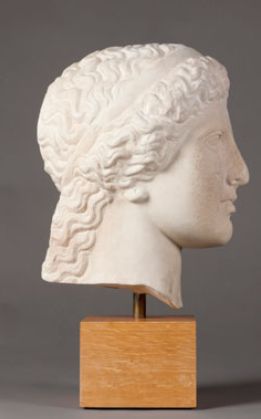
CC23: Goddess
Plaster cast, Ministry of Culture Casts and Reproductions, Greece, 1988
Purchased, 1996
Dimensions: H 32cm
Acc #: CC23, James Logie Memorial Collection
Copy of a marble head of a goddess, ca. 360 BC
Found at the Temple of Athena Alea at Tegea, Peloponnese, ca.1900-1910
National Archaeological Museum, Athens, #: 3602
Style
This head of a woman, probably a goddess, is an undated Roman copy of a Greek original. It is slightly larger than life size, and her gaze is downward and to the right, suggesting that the complete statue was originally positioned higher than the level of the viewer. Her thoughtful expression is typical of the Classical style. It also reflects the dominance of the gods in their relationship with humans.
Her hairstyle has the parting offset to the right and her hair is loosely pulled into a relaxed bun. Her face and hairstyle represent the aims of the Classical sculptors, as her features are more naturalistic than the previous Archaic and Severe styles.
History
The original head was found at the Temple of Athena Alea at Tegea, Peloponnese, ca.1900-1910, and has been identified previously as the goddess Hygeia. It has been suggested that this head was carved by the great fourth-century sculptor, Scopas of Paros, whom Pausanias identified as the architect of the temple of Athena constructed at her sanctuary at Tegea around 350 BC (see Description of Greece 8.45.5). Not all scholars accept the original work as one by Scopas, and the identification as Hygeia cannot be proven conclusively either. Hygeia was the goddes of hygiene and cleanliness, and she was the daughter of Asclepius, the god of healing. The sanctuary of Athena Alea at Tegea is not known as a healing sanctuary, and the goddess Athena’s specific powers do not include healing.
Athena’s epithet, Alea, may refer to the heroic founder king of Tegea, Aleus, who, according to Pausanias, built a temple to her at Tegea (Description of Greece 8.4.8; 8.45.4). However, the sanctuary and its functions have been re-examined following excavations by archaeologists at the Norwegian School at Athens from 1990-1996. They have proposed that numerous votives relating to the site in its second phase (late eighth-seventh centuries BC) represent Alea, who was, it is argued, an ancient protector of the town and a goddess of fertility. Athena Alea, therefore, represents both deities through her name.
Further Reading
A short selection of references for this work includes:
- Burnett Grossman, Janet. 2003. Looking at Greek and Roman Sculpture in Stone: A Guide to Terms, Styles, and Techniques. Los Angeles: Getty Publications
- Davidson Reid, Jane. 1993. The Oxford Guide to Classical Mythology in the Arts, 1300-1990s. Oxford: University Press
- Greek Ministry of Culture. 1988. Catalogue of Casts and Reproductions. Athens: Archaeological Receipts Fund
- Kaltsas, Nikolaos. 2002. Sculpture in the National Archaeological Museum, Athens. Los Angeles: Getty Publications
- Stillwell, Richard, William L. McDonald, and Marian Holland McAllister. 1976. The Princeton Encyclopedia of Classical Sites. New Jersey: Princeton University Press
- Voyatzis, M.E. 2004. “The cult of Athena Alea at Tegea and its transformation over time,” in M. Wedde, Celebrations: selected papers and discussions from the Tenth Anniversary Symposium of the Norwegian Institute at Athens, 12-16 May 1999 (Papers from the Norwegian Institute at Athens 6). http://corinth.sas.upenn.edu/dgr/sanctuaries/voyatzis2004.pdf

Side view of the Head of a Goddess

Reverse view of the Head of a Goddess

Front view of the Head of a Goddess